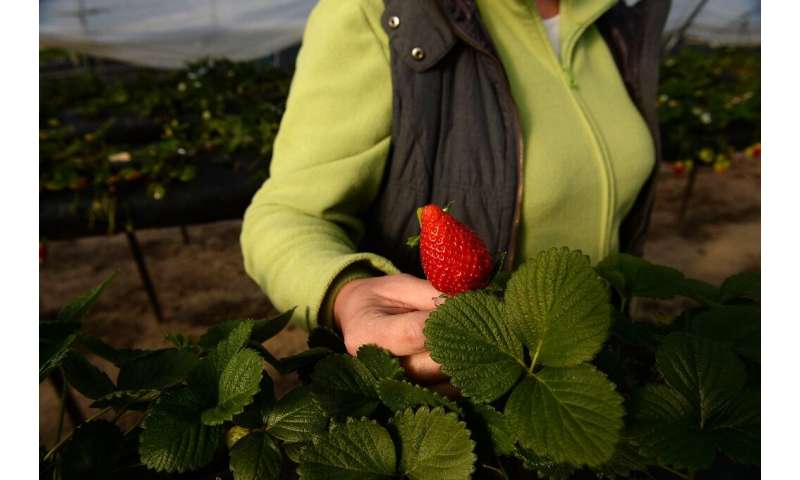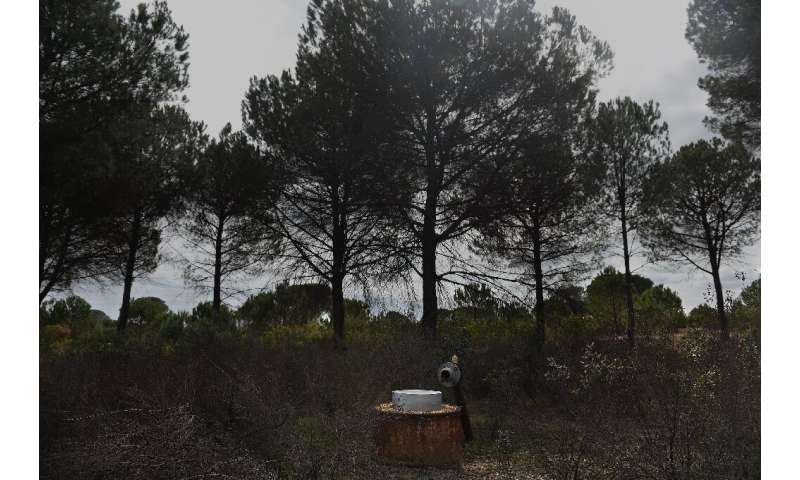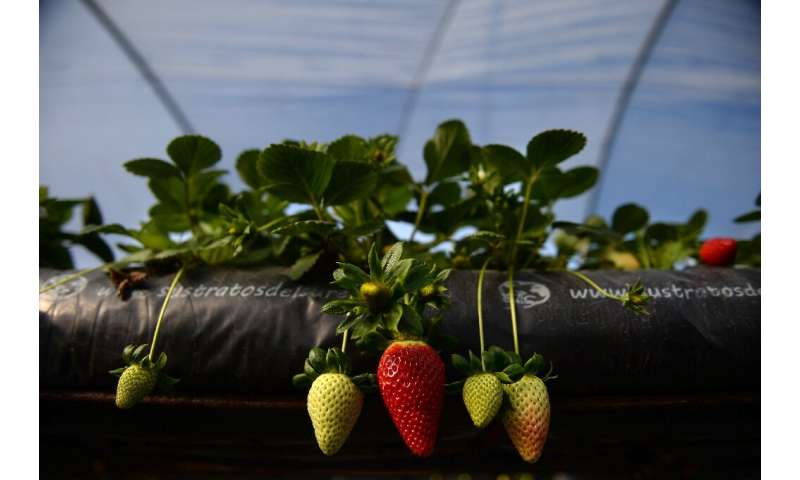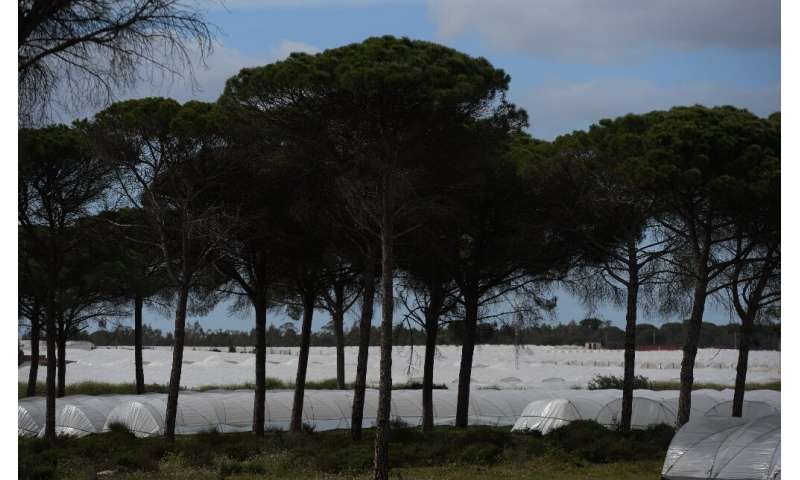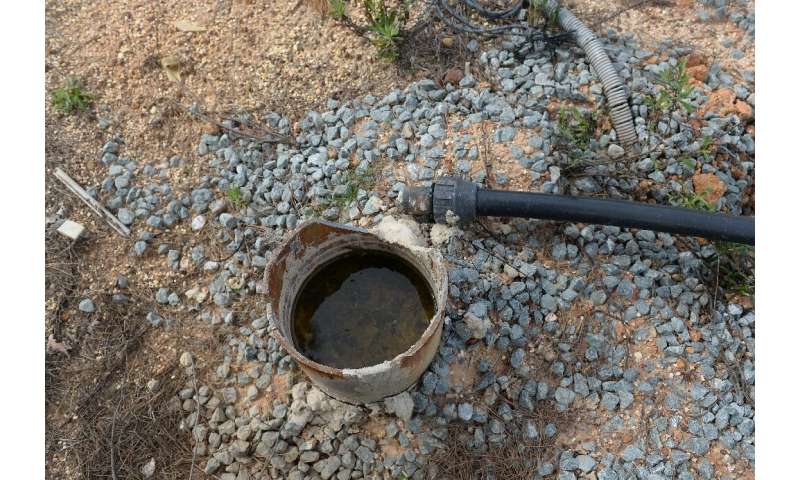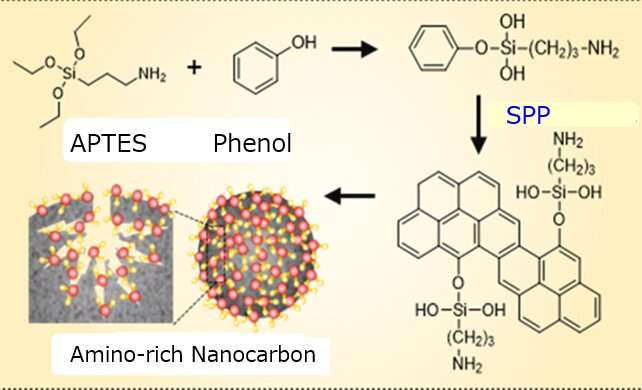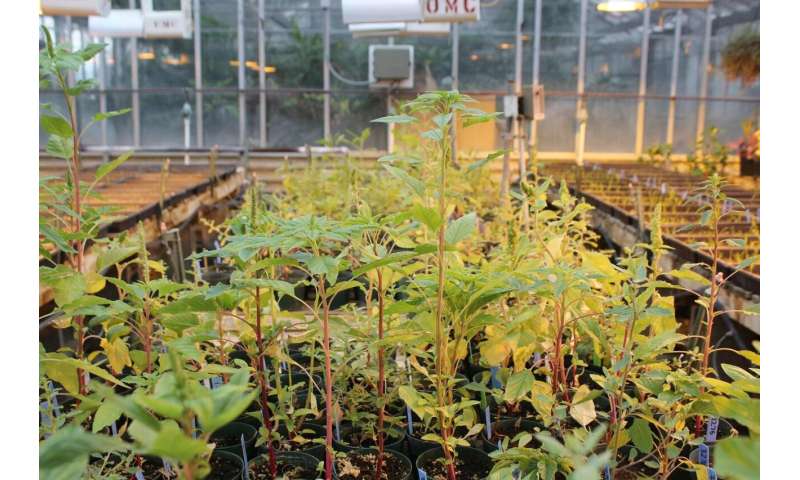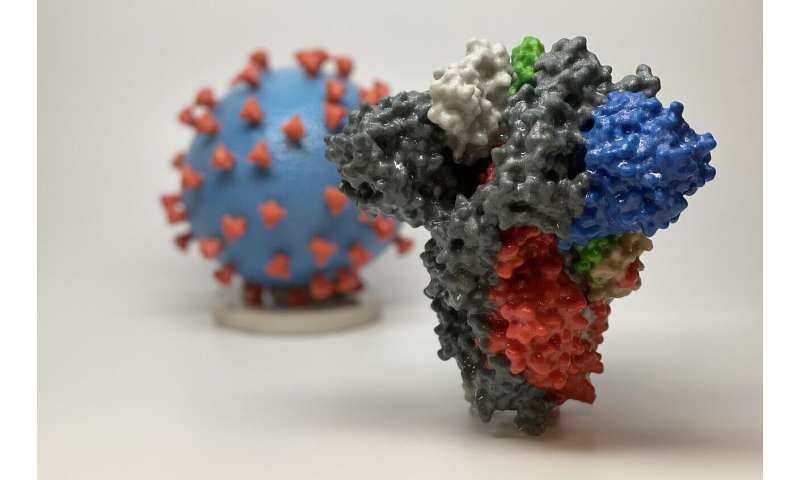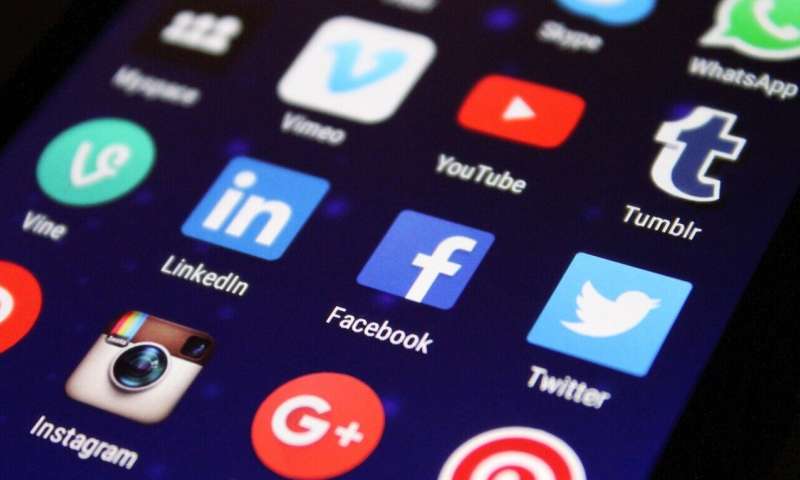by Moscow Institute of Physics and Technology
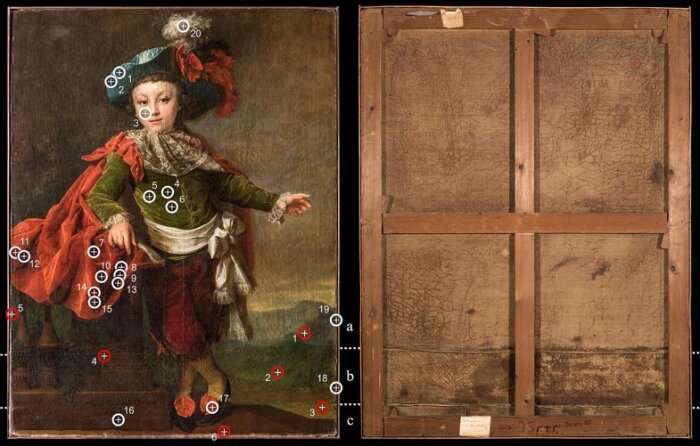
Left: The red circles indicate where samples were taken. The team avoided
sampling from the central part of the portrait. The areas noninvasively
examined via X-ray fluorescence spectroscopy are marked in white.
Right: The quality of the two seams seen on the back of the painting is different.
Credit: Nikolay Simonenko et al./Heritage ScienceRussian researchers from the Moscow Institute of Physics and Technology, Kurnakov Institute of General and Inorganic Chemistry of RAS, and Russia's famed Tretyakov Gallery have conducted a comprehensive preconservation study of "The Portrait of F.P. Makerovsky in a Masquerade Costume" (1789) by the Russian painter Dmitry Levitsky. The paper was published in the journal Heritage Science.
The portrait analyzed in the study is one of the masterpieces of the renowned painter's mature period and a rare example of a children's dress-up portrait in Russian art. However, rough restoration interventions of a century ago, thick layers of old yellowed varnish, and damage to the paint layer of unknown origin distorted the aesthetic perception of the image. The conservator, Tatiana Seregina, faced the difficult task of bringing the portrait as close to its original state as possible today, without affecting the painter's work.
"Our laboratory and the gallery's research team maintain a long-standing methodological collaboration, which manifested itself in a 2017 agreement between MIPT and the Tretyakov Gallery, with the support of its chief curator Tatiana Gorodkova," said Viktor Ivanov, the head of the Center for Functional Materials Testing at MIPT. "Under that agreement, we jointly develop approaches for comprehensive studies of artworks using modern methods for local analysis of materials and nanomaterials. The methodological expertise that we accumulated enabled us to participate in a preconservation study of the painting by Dmitry Levitsky and establish the unity of the paint layers across the entire canvas."
The research team comprised numerous physicists, chemists, art specialists, and conservators from MIPT, IGIC RAS, and the State Tretyakov Gallery.
Besides enabling more grounded decisions regarding the conservation techniques to be used, the analysis of the art materials also resolved a long-standing mystery. Levitsky's painting consists of three fragments, and while there were never any doubts concerning the authorship of the main part, it remained unknown when the two horizontal extension pieces with the figure from the knees down had been sewn to the canvas. While the extension pieces are visible in early-20th-century photographs, there were reservations about the earlier period in the painting's history, because of a distinct structure of the seams connecting the three fragments: While the upper seam is very neat, the lower one is much coarser.
"The last time the portrait underwent conservation was in 1914," study co-author Nikolay Simonenko from IGIC RAS and MIPT said. "We conducted a comprehensive preconservation analysis of art materials composition. This allowed us to establish that the extension pieces were indeed painted by Levitsky."
Painter in a hurry?
By analyzing the ground layers, the team first revealed a distinction between the main canvas and the extension pieces. The two layers of ground, customarily used by the painter, were only found in the main canvas. However, a closer look revealed the structure and composition of the ground in the two extensions to be alike. It also proved similar to the lower of the two ground layers of the main canvas.
The authors of the paper suggest that the painter might have had more time at the outset to thoroughly prepare the canvas. It is likely, the researchers hypothesize, that Levitsky's concept of the painting evolved as the work progressed, necessitating a bigger canvas. To accommodate his new vision, the painter first added one extension piece and then another.
Malachite pigment
By examining the paint layers, the team could show their similar composition across the entire painting, including the two extension pieces. Specifically, the green pigment is present in each of the three fragments and has a common nature: Infrared spectroscopy revealed it was malachite.
Interestingly, none of the other 10 or so analytic techniques used in the study could identify malachite, although elemental analysis did provide an indirect confirmation by detecting copper in the green paint. This is why the researchers had to employ such a wide range of tools in their study.
The common origin of the two extension pieces was also confirmed by the analysis of the brown pigment, which involved infrared and Raman spectroscopy, and scanning electron microscopy combined with energy dispersive X-ray spectroscopy.
By investigating the painted layer, the team established that it belonged to Levitsky in its entirety, confirming the hypothesis that a single artistic process united all three parts of the canvas.
Fine arts and hard sciences
In a research project like this, the chemists and physicists are after great detail in the results, which may in part go against the wish of the museum workers and conservators to preserve the work of art fully intact.
"In my opinion, the presence of art historians, chemists, and physicists in one team was key to the success of this endeavor," said Ivan Volkov, a chief researcher at the MIPT lab involved in the study. "We held regular meetings featuring both the Tretyakov Gallery team and us, materials scientists. We had to slowly work out a common language, but it was worth it. There was also an arrangement for the sampling methods and tools to be approved by the gallery staff."
With no room for error, the team needed to be very careful in taking samples, and extract maximum information from each of them. The researchers sought a middle ground to draw information from the portrait without damaging it. For example, some of the samples were taken from the edges of the painting.
New discoveries
This is the first time such a detailed and comprehensive study of a painting by Levitsky has been carried out. According to art specialists from the Tretyakov Gallery, the study has not only been important for preparing the conservation task, but also expanded the understanding of Levitsky's oeuvre and the late 18th-century art practice in Russia.
Now that the methodology has been developed and successfully tested, it can be applied to other works. Meanwhile, the conservation of Makerovsky's portrait is in its final stages, and it will soon return to the main exhibition. The conservation began long before the publication in Heritage Science and lasted about a year and a half.
The portrait analyzed in the study is one of the masterpieces of the renowned painter's mature period and a rare example of a children's dress-up portrait in Russian art. However, rough restoration interventions of a century ago, thick layers of old yellowed varnish, and damage to the paint layer of unknown origin distorted the aesthetic perception of the image. The conservator, Tatiana Seregina, faced the difficult task of bringing the portrait as close to its original state as possible today, without affecting the painter's work.
"Our laboratory and the gallery's research team maintain a long-standing methodological collaboration, which manifested itself in a 2017 agreement between MIPT and the Tretyakov Gallery, with the support of its chief curator Tatiana Gorodkova," said Viktor Ivanov, the head of the Center for Functional Materials Testing at MIPT. "Under that agreement, we jointly develop approaches for comprehensive studies of artworks using modern methods for local analysis of materials and nanomaterials. The methodological expertise that we accumulated enabled us to participate in a preconservation study of the painting by Dmitry Levitsky and establish the unity of the paint layers across the entire canvas."
The research team comprised numerous physicists, chemists, art specialists, and conservators from MIPT, IGIC RAS, and the State Tretyakov Gallery.
Besides enabling more grounded decisions regarding the conservation techniques to be used, the analysis of the art materials also resolved a long-standing mystery. Levitsky's painting consists of three fragments, and while there were never any doubts concerning the authorship of the main part, it remained unknown when the two horizontal extension pieces with the figure from the knees down had been sewn to the canvas. While the extension pieces are visible in early-20th-century photographs, there were reservations about the earlier period in the painting's history, because of a distinct structure of the seams connecting the three fragments: While the upper seam is very neat, the lower one is much coarser.
"The last time the portrait underwent conservation was in 1914," study co-author Nikolay Simonenko from IGIC RAS and MIPT said. "We conducted a comprehensive preconservation analysis of art materials composition. This allowed us to establish that the extension pieces were indeed painted by Levitsky."
Painter in a hurry?
By analyzing the ground layers, the team first revealed a distinction between the main canvas and the extension pieces. The two layers of ground, customarily used by the painter, were only found in the main canvas. However, a closer look revealed the structure and composition of the ground in the two extensions to be alike. It also proved similar to the lower of the two ground layers of the main canvas.
The authors of the paper suggest that the painter might have had more time at the outset to thoroughly prepare the canvas. It is likely, the researchers hypothesize, that Levitsky's concept of the painting evolved as the work progressed, necessitating a bigger canvas. To accommodate his new vision, the painter first added one extension piece and then another.
Malachite pigment
By examining the paint layers, the team could show their similar composition across the entire painting, including the two extension pieces. Specifically, the green pigment is present in each of the three fragments and has a common nature: Infrared spectroscopy revealed it was malachite.
Interestingly, none of the other 10 or so analytic techniques used in the study could identify malachite, although elemental analysis did provide an indirect confirmation by detecting copper in the green paint. This is why the researchers had to employ such a wide range of tools in their study.
The common origin of the two extension pieces was also confirmed by the analysis of the brown pigment, which involved infrared and Raman spectroscopy, and scanning electron microscopy combined with energy dispersive X-ray spectroscopy.
By investigating the painted layer, the team established that it belonged to Levitsky in its entirety, confirming the hypothesis that a single artistic process united all three parts of the canvas.
Fine arts and hard sciences
In a research project like this, the chemists and physicists are after great detail in the results, which may in part go against the wish of the museum workers and conservators to preserve the work of art fully intact.
"In my opinion, the presence of art historians, chemists, and physicists in one team was key to the success of this endeavor," said Ivan Volkov, a chief researcher at the MIPT lab involved in the study. "We held regular meetings featuring both the Tretyakov Gallery team and us, materials scientists. We had to slowly work out a common language, but it was worth it. There was also an arrangement for the sampling methods and tools to be approved by the gallery staff."
With no room for error, the team needed to be very careful in taking samples, and extract maximum information from each of them. The researchers sought a middle ground to draw information from the portrait without damaging it. For example, some of the samples were taken from the edges of the painting.
New discoveries
This is the first time such a detailed and comprehensive study of a painting by Levitsky has been carried out. According to art specialists from the Tretyakov Gallery, the study has not only been important for preparing the conservation task, but also expanded the understanding of Levitsky's oeuvre and the late 18th-century art practice in Russia.
Now that the methodology has been developed and successfully tested, it can be applied to other works. Meanwhile, the conservation of Makerovsky's portrait is in its final stages, and it will soon return to the main exhibition. The conservation began long before the publication in Heritage Science and lasted about a year and a half.
More information: Nikolay P. Simonenko et al, A study of "The Portrait of F.P. Makerovsky in a Masquerade Costume" by Dmitry Levitsky from the collection of the State Tretyakov Gallery, Heritage Science (2020). DOI: 10.1186/s40494-020-0351-1
Secrets of Lucretia painting closer to being revealed
by Northumbria University
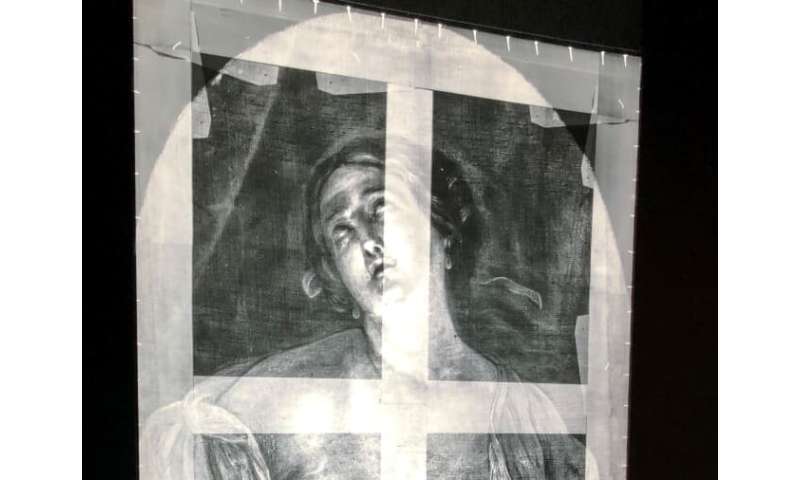
Secrets of Lucretia painting closer to being revealed
by Northumbria University

"The Death of Lucretia." Credit: The Bowes Museum
The mystery of who painted a centuries-old artwork, and when, is closer to being revealed thanks to the work of art conservation and forensic science experts from Northumbria University, in Newcastle upon Tyne.
"The Death of Lucretia" painting has been owned by the Bowes Museum in County Durham since the 1840s and has recently gone on display as part of an exhibition dedicated to the works of Italian Baroque master Guido Reni.
However, the origins of the painting are shrouded in mystery—it is believed the piece could be from the studio of Guido Reni, or at least painted during the same period in the seventeenth century, before then being significantly changed during a re-paint some 200 years later.
Now art conservator and Senior Lecturer Nicky Grimaldi and forensic scientist Dr. Michelle Carlin, both of Northumbria University, have worked in partnership with The Bowes Museum to help shed light on the history of the painting.
Using state-of-the-art technology and techniques, they have been able to look under the layer of paint which is visible to the naked eye—revealing a very different painting underneath the present day image.
Thanks to forensic techniques such as chemical analysis of the paint pigment, the pair have been able to identify when the different layers were painted and start to put together a picture of how and when the painting was created.
As Nicky Grimaldi explains: "When we first started working on this painting we had no idea what lay beneath, it was quite a revelation to find that there was essentially a whole other painting under the one we see today.
"The torso in the current version has been completely changed at some point, in the original version Lucretia was depicted wearing an elaborate bodice, which is now hidden.
"We believe the original version was probably left incomplete, but was then likely significantly repainted in the nineteenth century, before being sold through an art dealer in London and then arriving at Bowes Museum."
Chemical analysis of paint from the different layers has helped to date the painting, with the earlier paint containing much coarser particles than the paint added later.
As Dr. Michelle Carlin explains: "There was a clear difference in the particle size between the layers. The paint added at a later date was produced post-industrialization, by which time the process had become mechanized, meaning the particles were ground much finer. In contrast the particles in the paint underneath were much less refined.
"Similarly we were able to analyze the materials used to make the paint in the two layers and match this with what we know was available at the time to help determine when each layer was painted."
One of the most unexpected finds during the investigations was the presence of gold on the torso area of the painting, discovered by using a portable X-ray fluorescence spectrometry. This suggests the original bodice might have contained gold braid detailing.
Also discovered was the presence of titanium white in the panting, a pigment used by art conservators during the 20th century, suggesting the painting has been subject to conservation efforts in the past.
This ability to bring together experts in both art conservation and forensic science has led to Northumbria University developing an international reputation for this kind of specialist research.
The University has a long-standing relationship with The Bowes Museum, with the investigations into "The Death of Lucretia" carried out to coincide with the museum's new exhibition—"The Power and the Virtue: Guido Reni's The Death of Lucretia."
This exhibition has been conceived and developed by Bernadette Petti, Project Curator, who initiated the collaboration with Northumbria University and colleagues at The Hunterian and National Gallery.
Lucretia was an ancient Roman women who killed herself after being raped by the son of King Lucius Tarquinius Superbus. Her tragic death has been portrayed by many artists, with Lucretia often seen clutching a dagger to her chest.
Guido Reni (1575—1642) is the most famous Italian artist of his generation, with many of his works depicting female heroines, including Cleopatra, Mary Magdalene, Deianira and Lucretia.
The Bowes Museum exhibition presents works by Guido Reni from prestigious public and private collections, including The National Gallery and The Royal Collection.
Despite what Nicky Grimaldi and Dr. Michelle Carlin have already discovered, the mystery doesn't end there.
It is believed there is an almost identical copy of "The Death of Lucretia" in existence, suspected to be the original Reni painting from which the Bowes later repaint was copied from.
This painting could hold the answer to many of the questions the Northumbria researchers still have. However, it is believed the painting hasn't been in circulation since the early twentieth century and its whereabouts is presently unknown.
As Nicky Grimaldi explains: "It is quite common for copies of paintings to be made, sometimes by the original artists and sometimes by their studio apprentices or by other unrelated artists.
"We know there is another version of the image of Lucretia we see portrayed in the Bowes today. We suspect the other painting is still in Italy and has almost the same dimensions and composition, though unfortunately we don't know its exact location.
"If we could track this painting down it could be the missing piece of the puzzle and help us to fill in some of the gaps we have around the Bowes painting.
The mystery of who painted a centuries-old artwork, and when, is closer to being revealed thanks to the work of art conservation and forensic science experts from Northumbria University, in Newcastle upon Tyne.
"The Death of Lucretia" painting has been owned by the Bowes Museum in County Durham since the 1840s and has recently gone on display as part of an exhibition dedicated to the works of Italian Baroque master Guido Reni.
However, the origins of the painting are shrouded in mystery—it is believed the piece could be from the studio of Guido Reni, or at least painted during the same period in the seventeenth century, before then being significantly changed during a re-paint some 200 years later.
Now art conservator and Senior Lecturer Nicky Grimaldi and forensic scientist Dr. Michelle Carlin, both of Northumbria University, have worked in partnership with The Bowes Museum to help shed light on the history of the painting.
Using state-of-the-art technology and techniques, they have been able to look under the layer of paint which is visible to the naked eye—revealing a very different painting underneath the present day image.
Thanks to forensic techniques such as chemical analysis of the paint pigment, the pair have been able to identify when the different layers were painted and start to put together a picture of how and when the painting was created.
As Nicky Grimaldi explains: "When we first started working on this painting we had no idea what lay beneath, it was quite a revelation to find that there was essentially a whole other painting under the one we see today.
"The torso in the current version has been completely changed at some point, in the original version Lucretia was depicted wearing an elaborate bodice, which is now hidden.
"We believe the original version was probably left incomplete, but was then likely significantly repainted in the nineteenth century, before being sold through an art dealer in London and then arriving at Bowes Museum."
Chemical analysis of paint from the different layers has helped to date the painting, with the earlier paint containing much coarser particles than the paint added later.
As Dr. Michelle Carlin explains: "There was a clear difference in the particle size between the layers. The paint added at a later date was produced post-industrialization, by which time the process had become mechanized, meaning the particles were ground much finer. In contrast the particles in the paint underneath were much less refined.
"Similarly we were able to analyze the materials used to make the paint in the two layers and match this with what we know was available at the time to help determine when each layer was painted."
One of the most unexpected finds during the investigations was the presence of gold on the torso area of the painting, discovered by using a portable X-ray fluorescence spectrometry. This suggests the original bodice might have contained gold braid detailing.
Also discovered was the presence of titanium white in the panting, a pigment used by art conservators during the 20th century, suggesting the painting has been subject to conservation efforts in the past.
This ability to bring together experts in both art conservation and forensic science has led to Northumbria University developing an international reputation for this kind of specialist research.
The University has a long-standing relationship with The Bowes Museum, with the investigations into "The Death of Lucretia" carried out to coincide with the museum's new exhibition—"The Power and the Virtue: Guido Reni's The Death of Lucretia."
This exhibition has been conceived and developed by Bernadette Petti, Project Curator, who initiated the collaboration with Northumbria University and colleagues at The Hunterian and National Gallery.
Lucretia was an ancient Roman women who killed herself after being raped by the son of King Lucius Tarquinius Superbus. Her tragic death has been portrayed by many artists, with Lucretia often seen clutching a dagger to her chest.
Guido Reni (1575—1642) is the most famous Italian artist of his generation, with many of his works depicting female heroines, including Cleopatra, Mary Magdalene, Deianira and Lucretia.
The Bowes Museum exhibition presents works by Guido Reni from prestigious public and private collections, including The National Gallery and The Royal Collection.
Despite what Nicky Grimaldi and Dr. Michelle Carlin have already discovered, the mystery doesn't end there.
It is believed there is an almost identical copy of "The Death of Lucretia" in existence, suspected to be the original Reni painting from which the Bowes later repaint was copied from.
This painting could hold the answer to many of the questions the Northumbria researchers still have. However, it is believed the painting hasn't been in circulation since the early twentieth century and its whereabouts is presently unknown.
As Nicky Grimaldi explains: "It is quite common for copies of paintings to be made, sometimes by the original artists and sometimes by their studio apprentices or by other unrelated artists.
"We know there is another version of the image of Lucretia we see portrayed in the Bowes today. We suspect the other painting is still in Italy and has almost the same dimensions and composition, though unfortunately we don't know its exact location.
"If we could track this painting down it could be the missing piece of the puzzle and help us to fill in some of the gaps we have around the Bowes painting.

